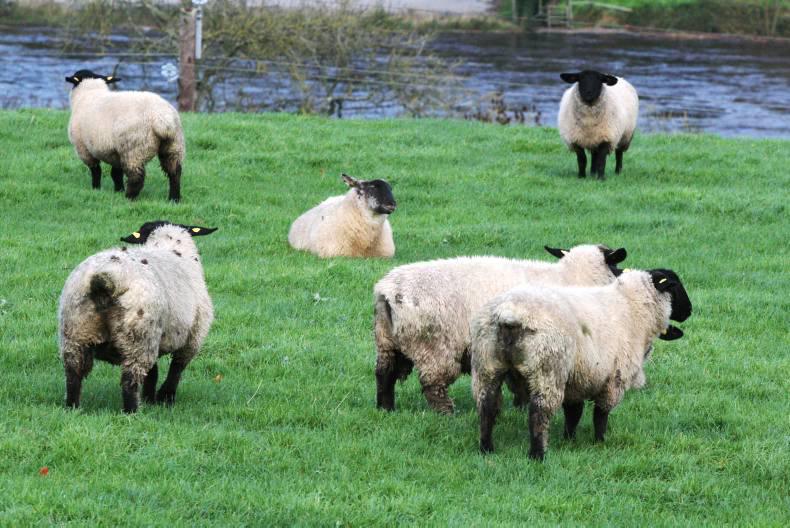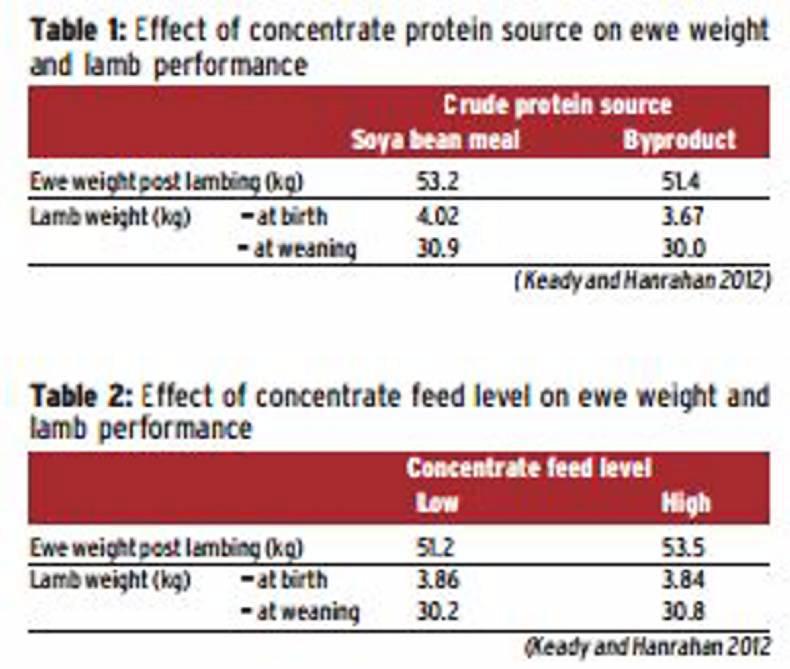During the last six weeks of pregnancy, the metabolisable energy and metabolisable protein requirements of twin-bearing ewes increase by 60% and 35%, respectively.
Some concentrates are manufactured using least cost ration formulations, so the ingredient composition will vary dramatically. Many concentrates currently offered to ewes in late pregnancy do not contain soya bean meal or cereals. Soya bean meal, while expensive, is a good source of microbial protein, the demand for which increases in late pregnancy. A study at Teagasc Athenry evaluated the effects of the source of concentrate protein and concentrate feed level on the performance of ewes in late pregnancy and the performance of their progeny.
Study
The study used twin- and triplet-bearing ewes in late pregnancy, which were due to lamb in mid-March for the first time as two-year-olds. The ewes were housed in mid-December. While housed, the ewes received grass silage (74% DMD) ad-libitum.
During the last six weeks of pregnancy, the ewes were offered either low or high levels of concentrate supplementation. The levels offered to the twin-bearing ewes were 16kg and 28kg, while the triplet-bearing ewes got 21kg and 32kg, respectively. Two concentrates were offered, containing either soya bean meal or by-products as the main protein ingredients.
Concentrates
The two concentrates were formulated to contain similar crude protein (18% fresh weight) and metabolisable energy (12.4 MJ/kg DM) concentrations. The soya bean meal-based concentrate contained barley, soya bean meal, citrus pulp, soya hulls and sugar beet pulp as the main ingredients. The by-product-based concentrate contained maize gluten, rapeseed meal, maize distillers, barley, citrus pulp, soya hulls and sugar beet pulp as the main ingredients.
Concentrate was offered to the ewes once daily. The effects of concentrate protein source on ewe and lamb performance are shown in Table 1. Ewes offered the soya bean meal-based concentrate, regardless of concentrate feed level, produced lambs which were heavier at birth (+0.35kg) and at weaning (+0.9kg).
The effects of concentrate feed level on ewe and lamb performance are presented in Table 2. Increasing concentrate feed level in late pregnancy did not significantly affect lamb birth or lamb weaning weights. The results of this study clearly show that concentrate ingredient composition had a greater effect on animal performance than increasing concentrate feed level by 75%.
Costs and benefits
The soya bean meal-based concentrate cost €20/t more than the by-product-based concentrate. Therefore, for twin-bearing ewes which were offered 16kg concentrates in late pregnancy, offering the soya bean meal based concentrate increased concentrate cost by only €0.32/ewe, while increasing individual lamb weaning weight by 0.9kg.
For twin-bearing ewes, soya bean meal inclusion in the concentrate in late pregnancy increased the weight of lambs weaned per ewe by 1.8kg for a cost of only €0.32. To put this into perspective, to increase lamb weaning weight by 0.9kg due to creep feeding pre-weaning would require 7kg of concentrate per lamb, which is equivalent to a cost of €4.20 per set of twins.
Increasing the feed level of concentrate to ewes in late pregnancy from 16kg to 28kg increased concentrate costs by €3.12 per ewe, without a significant improvement in subsequent lamb performance.
Key points
Soya bean meal inclusion increased lamb birth and weaning weights.Including soya bean meal in the ewe ration resulted in a greater increase in lamb performance than increasing concentrate feed level by 75%. The soya bean meal-based concentrate was only €20/t more expensive than the by-product-based concentrate (equivalent to only €0.32 per ewe), but increased the weight of lamb weaned per twin-rearing ewe by 1.8kg. Focus on ingredient composition when purchasing concentrate.This article was first published on 4 February 2012
During the last six weeks of pregnancy, the metabolisable energy and metabolisable protein requirements of twin-bearing ewes increase by 60% and 35%, respectively.
Some concentrates are manufactured using least cost ration formulations, so the ingredient composition will vary dramatically. Many concentrates currently offered to ewes in late pregnancy do not contain soya bean meal or cereals. Soya bean meal, while expensive, is a good source of microbial protein, the demand for which increases in late pregnancy. A study at Teagasc Athenry evaluated the effects of the source of concentrate protein and concentrate feed level on the performance of ewes in late pregnancy and the performance of their progeny.
Study
The study used twin- and triplet-bearing ewes in late pregnancy, which were due to lamb in mid-March for the first time as two-year-olds. The ewes were housed in mid-December. While housed, the ewes received grass silage (74% DMD) ad-libitum.
During the last six weeks of pregnancy, the ewes were offered either low or high levels of concentrate supplementation. The levels offered to the twin-bearing ewes were 16kg and 28kg, while the triplet-bearing ewes got 21kg and 32kg, respectively. Two concentrates were offered, containing either soya bean meal or by-products as the main protein ingredients.
Concentrates
The two concentrates were formulated to contain similar crude protein (18% fresh weight) and metabolisable energy (12.4 MJ/kg DM) concentrations. The soya bean meal-based concentrate contained barley, soya bean meal, citrus pulp, soya hulls and sugar beet pulp as the main ingredients. The by-product-based concentrate contained maize gluten, rapeseed meal, maize distillers, barley, citrus pulp, soya hulls and sugar beet pulp as the main ingredients.
Concentrate was offered to the ewes once daily. The effects of concentrate protein source on ewe and lamb performance are shown in Table 1. Ewes offered the soya bean meal-based concentrate, regardless of concentrate feed level, produced lambs which were heavier at birth (+0.35kg) and at weaning (+0.9kg).
The effects of concentrate feed level on ewe and lamb performance are presented in Table 2. Increasing concentrate feed level in late pregnancy did not significantly affect lamb birth or lamb weaning weights. The results of this study clearly show that concentrate ingredient composition had a greater effect on animal performance than increasing concentrate feed level by 75%.
Costs and benefits
The soya bean meal-based concentrate cost €20/t more than the by-product-based concentrate. Therefore, for twin-bearing ewes which were offered 16kg concentrates in late pregnancy, offering the soya bean meal based concentrate increased concentrate cost by only €0.32/ewe, while increasing individual lamb weaning weight by 0.9kg.
For twin-bearing ewes, soya bean meal inclusion in the concentrate in late pregnancy increased the weight of lambs weaned per ewe by 1.8kg for a cost of only €0.32. To put this into perspective, to increase lamb weaning weight by 0.9kg due to creep feeding pre-weaning would require 7kg of concentrate per lamb, which is equivalent to a cost of €4.20 per set of twins.
Increasing the feed level of concentrate to ewes in late pregnancy from 16kg to 28kg increased concentrate costs by €3.12 per ewe, without a significant improvement in subsequent lamb performance.
Key points
Soya bean meal inclusion increased lamb birth and weaning weights.Including soya bean meal in the ewe ration resulted in a greater increase in lamb performance than increasing concentrate feed level by 75%. The soya bean meal-based concentrate was only €20/t more expensive than the by-product-based concentrate (equivalent to only €0.32 per ewe), but increased the weight of lamb weaned per twin-rearing ewe by 1.8kg. Focus on ingredient composition when purchasing concentrate.This article was first published on 4 February 2012






 This is a subscriber-only article
This is a subscriber-only article











SHARING OPTIONS: